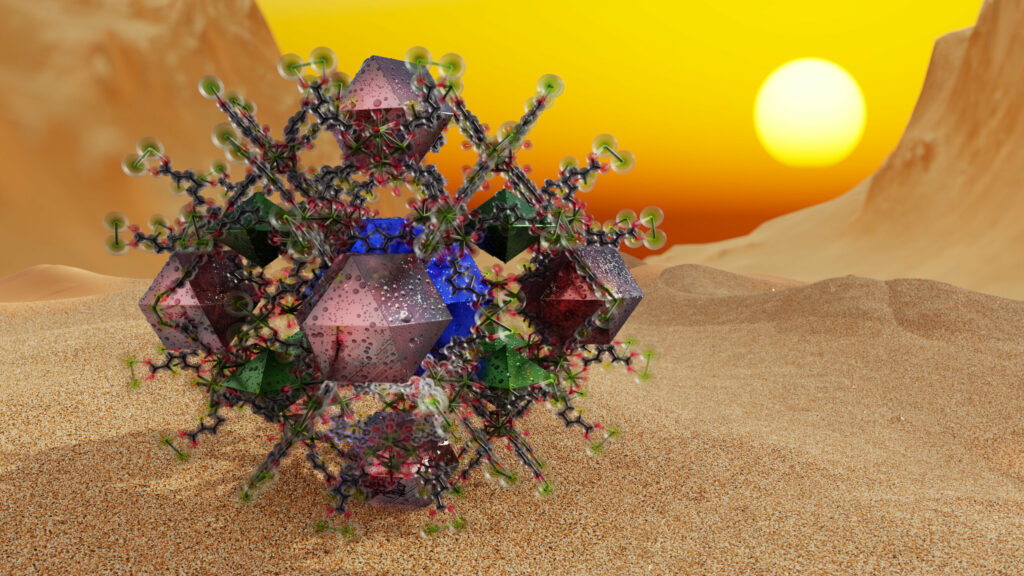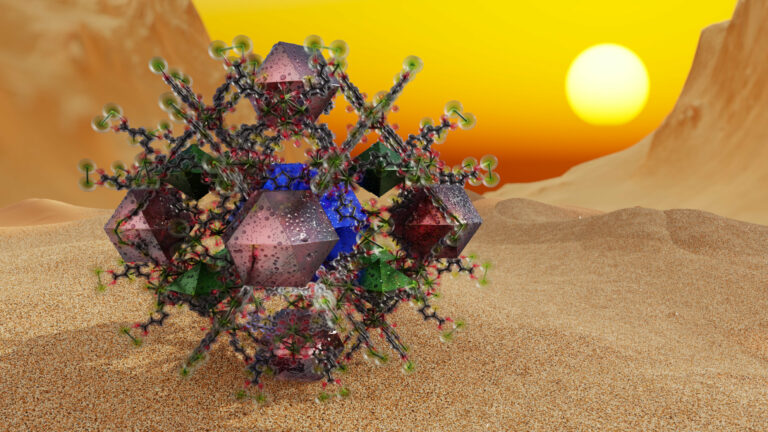Uncovering the Mechanism of Water Capture from the Air: Insights from Metal-Organic Frameworks Research
Researchers from Helmholtz-Zentrum Dresden-Rossendorf and Dresden University of Technology have deciphered the mechanism of water adsorption in specific microporous materials known as hierarchical metal-organic frameworks (MOFs), examining them at the atomic level. These unique materials, discovered approximately 25 years ago, earned a reputation as “miracle materials” due to their exceptional properties, including the ability to extract water from the air.
The scientists detail the process by which the material accomplishes this feat in ACS Applied Materials & Interfaces. “These extraordinary materials consist of highly porous solids composed of metals or metal-oxygen clusters interconnected modularly by pillars of organic chemicals. This 3D arrangement creates networks of cavities reminiscent of a kitchen sponge’s pores. It is precisely these cavities that capture our interest,” explains Dr. Ahmed Attallah from HZDR’s Institute of Radiation Physics. These nanoscale pores serve as the basis for a myriad of potential applications, spanning from gas storage to separation technology, catalysis, innovative sensors, and water harvesting, emerging as one of the most promising applications.

Probing the void
The research team synthesized two metal-organic frameworks (MOFs) using zirconium and hafnium metals, both anchored in the same organic framework. Subsequently, they conducted a comprehensive analysis of the acquired materials using various complementary techniques. On one front, they quantified the amount of nitrogen or water vapor that could be sequestered within the material’s pores.
Simultaneously, they delved into the intricate details of the water adsorption mechanism in MOFs, a process that had remained poorly understood until now. “To elucidate the process, we employed a non-destructive method called positron annihilation lifetime spectroscopy, or PALS for short, where a positron interacts with its antiparticle, electrons, leading to annihilation and the subsequent release of detectable gamma rays,” explained Dr. Andreas Wagner, the head of the ELBE Center for High-Power Radiation Sources at HZDR.
“The time interval between positron emission from a radioactive source and the detection of gamma rays constitutes the positrons’ lifetime, dependent on how rapidly they encounter electrons.” In the presence of voids such as nanopores in the material, positrons and electrons tend to form positronium atoms, each comprising one electron and one positron, orbiting their common center of mass. These exotic atoms persist longer in larger voids, offering insights into the void’s size and distribution. The researchers observed that water adsorption in the MOFs primarily followed a step-wise filling mechanism, involving the creation of liquid bridges within the pores. This process was influenced by the formation of water clusters on the pore surface, leading to the generation of small air gaps within the pores.
Squeezing out desert air
“Due to the close chemical similarity between the metals zirconium and hafnium, the resulting metal-organic frameworks exhibit identical pore sizes and high chemical stability. This similarity allows us to assess the validity of our method simultaneously,” explains Prof. Stefan Kaskel, Chair of Inorganic Chemistry I at Dresden University of Technology.
His research group focuses on developing innovative functional materials for diverse applications, including energy storage and conversion, environmental catalysis, and water adsorption. Based on the findings, the researchers assert that their study offers new insights into the water adsorption mechanism in hierarchical MOFs. This understanding could aid in designing improved materials for harvesting water from the air, particularly crucial in arid regions.
MOFs, when exposed to air, can capture water molecules from the atmosphere, and by applying heat or reducing pressure, the water can be released and utilized. Thinking ahead, the scientists consider the technology’s suitability for commercial solutions. As reported by another group in the field, an estimated yield of 1.3 liters of water per kilogram of MOF per day from desert air provides an indication of the current practical achievable output. However, for an overall sustainable solution, additional factors must be considered beyond yield. “To scale up water harvesting with MOFs, they must be readily available in large quantities at a low cost.
Additionally, traditional synthesis methods involve significant quantities of organic solvents or the acquisition of expensive building blocks,” note Kaskel and Attallah, highlighting potential challenges in this endeavor. To address these challenges, recently developed “green” synthesis procedures are expected to gain prominence, ensuring an eco-friendly production of MOFs. The Dresden team is already embracing this approach by adhering to the principles of green chemistry, such as using water as a solvent, conducting reactions at energy-saving low temperatures, and sourcing metals and organic linkers from waste materials.
This article is republished from PhysORG under a Creative Commons license. Read the original article.
Do not forget to share your opinion with us to provide you with the best posts !




0 Comments